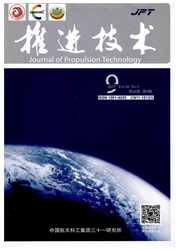

 中文摘要:
中文摘要:
为了发展可行的超声速湍流燃烧大涡模拟方法,将设定型PDF(Probability Density Function)模型与LES(Large Eddy Simulation)相结合以封闭亚格子湍流-燃烧相互作用,并将模型用于支板喷射超声速湍流燃烧流场的数值模拟。分别对冷流及燃烧流场进行了模拟,计算结果与实验测量符合较好,表明了所采用方法及模型的可行性。冷流条件下,大尺度湍流涡通过卷吸、拉伸运动主导支板尾迹区的近场混合,并通过破碎过程影响远场混合。燃烧条件下,回流区尺度扩大,剪切层中形成的高温燃烧产物通过大涡卷吸以及回流区末端对流作用进入回流区并与其中的燃料喷流相互作用,使部分燃料预热升温并进入回流区两侧剪切层与主流空气混合、燃烧,从而实现火焰稳定。在薄反应剪切层及大尺度反应涡的边界区域,LES网格不足以直接求解湍流与燃烧的相互作用,PDF模型给出了较强的亚格子脉动。
 英文摘要:
英文摘要:
In order to develop a feasible method for large eddy simulation of supersonic turbulent combustion, an assumed sub-grid PDF (Probability density Function) model was combined with large eddy simulation to close the sub-grid turbulence- combustion interaction. Then the model was used to simulate the supersonic combustion flowfield behind a strut injector. Sim- ulations were carried out for both nonreacting and reacting flows, where the calculations agreed well with the experiments, in- dicating the feasibility of the present methods and models. In the nonreacting flow, large scale vortices dominate the near-field mixing by rolling and stretching, and influence the far-field mixing via breaking up to smaller vortices. In the reacting flow, the recirculation region becomes larger due to the heat release. The hot products generated in the shear layers enter into the re- circulation region by entrainment of large vortices and convection at the end of the recirculation region. In the recirculation re- gion, the hot products interact with the fuel jets, heating them and forcing part of the fuel into the shear layers to mix and react with the air in the free stream. The LES mesh is not fine enough to resolve the interaction of turbulence and combustion in the thin reacting shear layers and around the boundaries of large reacting vortices, where the PDF model gives higher sub-grid fluctuations.
 同期刊论文项目
同期刊论文项目
 同项目期刊论文
同项目期刊论文
 Flame Stabilization in a Supersonic Combustor with Hydrogen Injection Upstream of Cavity flameholder
Flame Stabilization in a Supersonic Combustor with Hydrogen Injection Upstream of Cavity flameholder A modified sub-cell-fix method for re-initialization of level-set distance function and its dependen
A modified sub-cell-fix method for re-initialization of level-set distance function and its dependen Spark ignition process in a scramjet combustor fueled by hydorgen and equipped with multi-cavities a
Spark ignition process in a scramjet combustor fueled by hydorgen and equipped with multi-cavities a Combustion characteristics in a supersonic combustor with hydrogen injection upstream of cavity flam
Combustion characteristics in a supersonic combustor with hydrogen injection upstream of cavity flam Spark ignition process in a scramjet combustor fueled by hydrogen and equipped with multi-cavities a
Spark ignition process in a scramjet combustor fueled by hydrogen and equipped with multi-cavities a Adaptive mesh refinement based numerical simulation of detonation initiation in supersonic combustib
Adaptive mesh refinement based numerical simulation of detonation initiation in supersonic combustib Flow patterns and mixing characteristics of gaseous fuel multiple injections in a non-reacting super
Flow patterns and mixing characteristics of gaseous fuel multiple injections in a non-reacting super A hybrid LES (Large Eddy Simulation)/assumed sub-grid PDF (Probability Density Function) model for s
A hybrid LES (Large Eddy Simulation)/assumed sub-grid PDF (Probability Density Function) model for s A dynamic pressure-sink method for improving large eddy simulation and hybrid Reynolds-averaged Navi
A dynamic pressure-sink method for improving large eddy simulation and hybrid Reynolds-averaged Navi Influence analysis of geometrical parameters of detonation initiation with a hot jet by adaptive mes
Influence analysis of geometrical parameters of detonation initiation with a hot jet by adaptive mes 期刊信息
期刊信息
